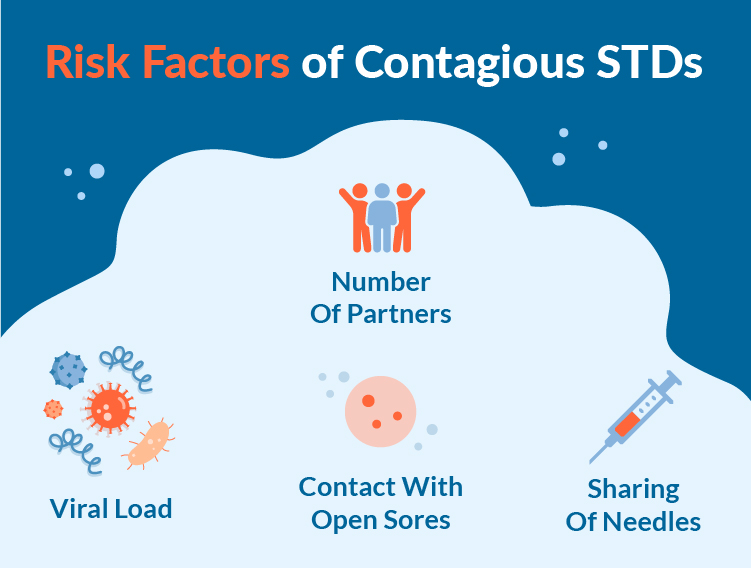While each sexually transmitted disease (STD) can pose varying degrees of transmission risk and methods in which they can be spread, all STDs are contagious. STDs can be spread at any time after initial infection, certain STIs have periods of viral shedding when the virus multiplies and can then be exposed outside the body. The presence of open sores can also increase the risk of spread through bodily fluids. Understandably, talking about the risk of STD infection can make anyone a little uneasy, but having knowledge of STDs, how they are transmitted and when they are most contagious can not only protect your sexual health but others as well! By remaining informed and regularly seeking out STD testing, as recommended by the Centers for Disease Control (CDC) for sexually active individuals between the ages of 13 to 64, you will be taking all the necessary steps to avoid these contagious sexually transmitted infections.1
How Are STDs Contagious?
All STDs are similar in the sense that they are all contagious and can be transmitted through sexual interactions such as oral, anal or vaginal sex. However, there are specific traits for each virus or bacterial infection that can affect risk. The risk of contracting an STD can be affected by factors such as viral load, number of partners, contact with open sores, or the sharing of needles.
Is chlamydia contagious?
Chlamydia is one of the more common sexually transmitted infections and is highly contagious, partially due to a common lack of symptoms. Chlamydia symptoms usually present themselves in the form of discharge or uncomfortable urination, both of which can easily be mistaken for a UTI. However, this STI is easily overlooked and can increase in severity without being noticed. According to the CDC, this bacterial STI can be spread through anal, vaginal or oral sex and can be caught again after treatment if exposed.2 However, chlamydia is not contagious through casual contact such as shaking hands or hugging.
Is gonorrhea contagious?
Another very common and contagious STI would be gonorrhea. Similar to chlamydia, this bacteria doesn’t typically demonstrate signs of infection. Gonorrhea symptoms may include abnormal discharge, pain during sex or spotting between periods, but this infection is more often asymptomatic which can lead to unintentional transmission. Since this infection usually doesn’t show signs, the CDC says that it can be easy for the bacteria to spread during unprotected anal, vaginal or oral sex.3 This infection, however, is not contagious in the sense that it cannot be spread through normal, day-to-day activities or interactions.
Is hepatitis B contagious?
On the flip side, hepatitis B is a contagious infection that can be spread through sexual contact, blood or other bodily fluids. Since this virus is characterized as a blood-borne disease, it can be spread through vaginal, anal or oral sex and also by sharing or using contaminated needles or syringes, as explained by the CDC.4 It can also remain contagious outside the body for about 7 days, and people usually do not experience any hepatitis B symptoms. But, while fairly contagious, this STD does not spread through common interactions such as sharing utensils, a drink or kissing. Also, unlike the aforementioned bacterial infections, once you have had hepatitis B, you cannot contract it again4.
Is hepatitis C contagious?
Hepatitis C is similar to B in the sense that they cause inflammation of the liver and are both pretty contagious. Just like its B variant, this STD is contagious and can be spread through sex, blood, semen and other bodily fluids, but not through kissing, holding hands, hugging or other casual interactions. There are many different genotypes of the hepatitis C virus, so it is possible to become reinfected with another strain, as mentioned by the CDC.5 While hepatitis C symptoms are not very common in the acute or chronic stages of this STD, they can take up to a couple of weeks to months before showing.5
Is HIV contagious?
HIV is another contagious STD. As explained by the CDC, HIV is typically spread through vaginal or anal sex, the sharing of needles and or mother-to-child transmission.6 This risk of transmission increases in correlation with the infection’s viral load (how prevalent the virus is throughout the body)7. While it is very rare, it is possible for this STD to be contagious through other means such as bites, open-mouth kissing and tattoo needles.6 But, contrary to popular belief, HIV cannot be spread through commonplace interactions such as closed-mouthed kissing or sharing dishes6.
Is trichomoniasis contagious?
Trichomoniasis is a unique STD because instead of being brought about by bacteria or a virus, this contagious STD is due to a protozoan parasite. Like other STDs, people do not usually experience trichomoniasis symptoms and are more likely to be asymptomatic. Even though the CDC reported millions of infections in their 2018 report, trichomoniasis is one of the most common curable STDs.8 However, this STD can spread fairly easily and women experience a greater sum of infections than men.8 This STI can be spread from person to person but is usually only found in the genital region (rarely in other areas of the body such as the anus or mouth).8 While the limitations of this infection are comforting, trichomoniasis remains pretty contagious and should not be taken lightly.
Is syphilis contagious?
Syphilis, similar to other bacterial STIs, is a contagious STD. Syphilis, as explained by the CDC, is spread through contact with a sore caused by the STD.9 These contagious syphilis symptoms are often raised and painless sores that usually appear during the primary and secondary stages, but disappear during the latent (asymptomatic stage) of the infection.9 It can also be passed from mother to child during pregnancy9. Due to the latent stage of this STD, it is very easy for syphilis to develop into complications before being noticed or diagnosed.
Is herpes contagious?
Herpes is a considerably contagious STD primary due to the herpes symptoms that it is capable of causing. This STD is caused by a virus that normally does not express itself with symptoms. However, the CDC clarifies that this infection can present itself in the form of contagious herpes lesions.10 Direct contact with these lesions or infected bodily fluids (oral or genital) presents a risk for transmission as well.10 Herpes is also known for its viral shedding which can make the skin around the infected area carry the STD as well.10
Conclusion
These STDs, both viral and bacterial, are all quite contagious and can spread fairly easily. While all STDs can spread through unprotected sex, there are certain features of each infection that can increase or decrease its risk for transmission. But of course, no one should take a gamble when it involves their sexual health. The use of protective measures such as male and female condoms and dental dams can all help prevent you or your partner(s) from contracting an STI.
However, these protective measures are limited by their correct, repeated use and coverage, and mistakes happen. Since STDs never always present signs, it is always recommended to get tested at a reliable STD testing center regularly or when you might suspect an infection. It can be easy to second guess the facts surrounding sexual health and the technicalities of each STD, but as a general rule–all STDs are contagious but preventative measures and testing can ensure that you stay healthy and up-to-date on your sexual well-being.
Sources
- “Which STD Tests Should I Get?.” Centers for Disease Control and Prevention. December 14, 2021. www.cdc.gov/std/prevention/screeningreccs.htm.
- “STD Facts – Chlamydia.” Centers for Disease Control and Prevention. Centers for Disease Control and Prevention, January 23, 2014. www.cdc.gov/std/chlamydia/stdfact-chlamydia.htm.
- “STD Facts – Gonorrhea.” Centers for Disease Control and Prevention. Centers for Disease Control and Prevention, January 29, 2014. www.cdc.gov/std/gonorrhea/stdfact-gonorrhea.htm.
- “What is Hepatitis B – FAQ.” Centers for Disease Control and Prevention. Centers for Disease Control and Prevention, July 28, 2020. www.cdc.gov/hepatitis/hbv/bfaq.htm.
- “Hepatitis C Questions and Answers for Health Professionals.” Centers for Disease Control and Prevention. Centers for Disease Control and Prevention, August 7, 2020. www.cdc.gov/hepatitis/hcv/hcvfaq.htm#section1.
- “Ways HIV Can Be Transmitted.” Centers for Disease Control and Prevention. Centers for Disease Control and Prevention, November 3, 2020. https://www.cdc.gov/hiv/causes/.
- “STD Facts – Trichomoniasis.” Centers for Disease Control and Prevention. Centers for Disease Control and Prevention, January 19, 2021. www.cdc.gov/std/trichomonas/stdfact-trichomoniasis.htm.
- “STD Facts – Syphilis.” Centers for Disease Control and Prevention. Centers for Disease Control and Prevention, June 8, 2017. www.cdc.gov/std/syphilis/stdfact-syphilis.htm.
- “STD Facts – Genital Herpes (Detailed version).” Centers for Disease Control and Prevention. Centers for Disease Control and Prevention, January 19, 2021. www.cdc.gov/std/herpes/stdfact-herpes-detailed.htm.


